Tabla Drum Terminology
Notes:
- All terms below apply to both drums, unless indicated otherwise.
- There are different terms and variant spellings/pronunciations for some terms. I include only the most common and/or those used on this website.
The Six Terms Every Tabla Student Should Know
- Dāyā (high-pitched drum)
- Bāyā (low-pitched drum)
- Purī (drum head)
- Chānṭī / Kinār (edge or rim of drum)
- Low / Maidān / Sur (area between chanti and syahi)
- Syāhī (black patch on drum head)
There are other important terms in this section, but these are the six that tabla students will use most often.
The Two Drums
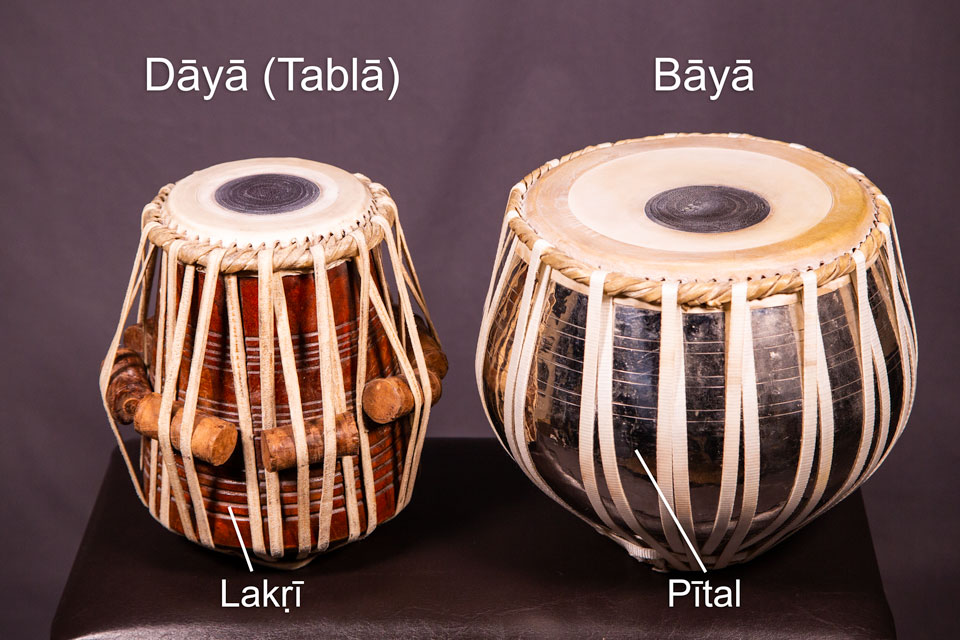
Daya and Baya, Made of Wood and Brass
Dāyā – दायाँ
Also called tablā (तबला).
Dāyā refers to the smaller, high-pitched drum. Dāyā, or dāhinā (दाहिना), means "right" or "right hand" in Hindi. Even for left-handed tabla players, this drum is always called dāyā.
The term tabla also refers to this smaller drum. However, tabla also commonly refers to the pair of drums together.
In Latin script, daya is commonly written dayan, or even dayam. This is because the second a vowel is nasalized. However, there is no actual n or m consonant at the end of the word. Simply saying dāyā with two long ā vowels will sound closer to the proper pronunciation.
Bāyā – बायाँ
Also called ḍuggī (डुग्गी) or ḍaggā (डग्गा).
The bāyā refers to the larger, low-pitched drum. Bāyā means "left" or "left hand" in Hindi. And as with the daya, this drum is always called baya, even for left-handed tabla players.
Baya is also often written as bayan or bayam because of the nasalized second vowel. But here too there is no actual n or m sound.
Lakṛī – लकड़ी
Lakṛī means "wood", and refers to the daya’s shell. The most common kind of wood is shisham (Indian Rosewood), though other kinds are also used.
Pītal – पीतल
The baya’s shell is commonly made of pītal, meaning "brass". This is usually plated with nickel. Other common materials for the baya’s shell include copper (tāmbā – ताँबा), and clay (miṭṭī – मिट्टी).
The Puṛī and Terms Related to Technique
Puṛī – पुड़ी
The puṛī is the drum head (literally "skin of the drum"). The main skin and the upper ring of leather (darker shade) are made from goat skin. The braided outer ring (the gajrā) is made of a stronger rawhide such as buffalo.
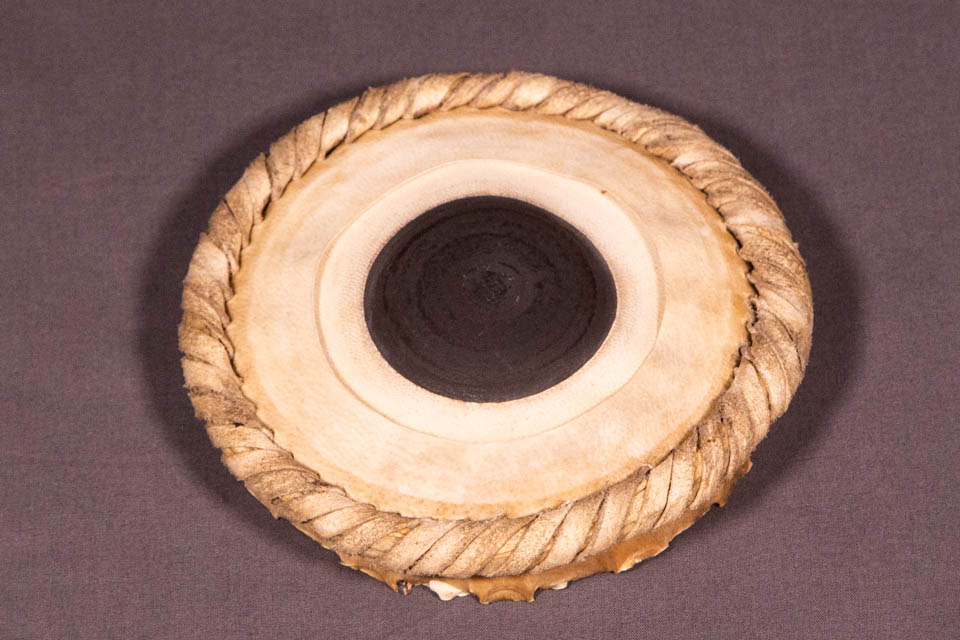
Tabla Puri
Puri Terms Related to Technique
For the daya’s puri, there are three terms that are especially important in relation to tabla technique: chānṭī, low , and syāhī:
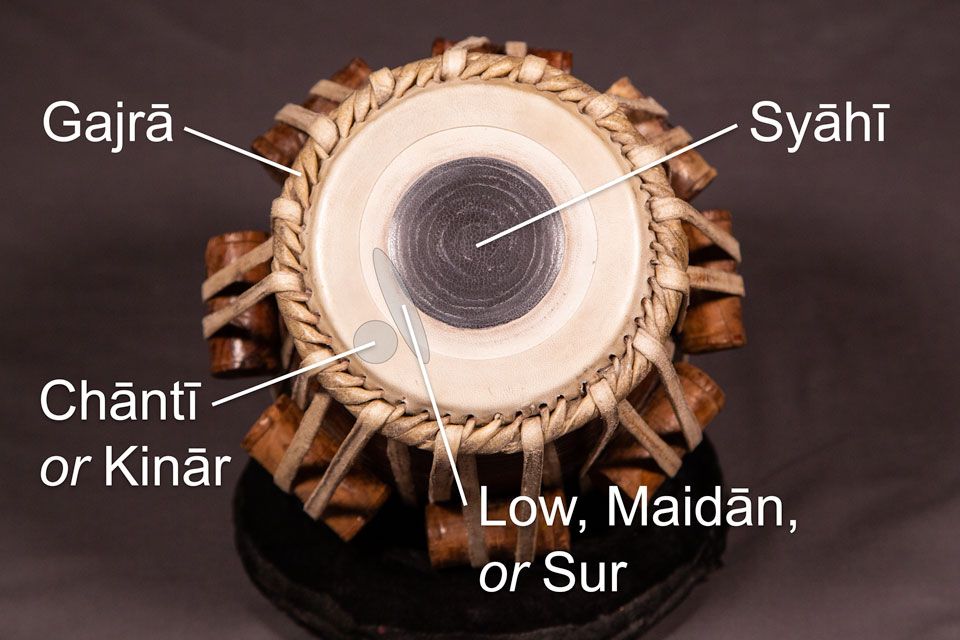
Parts of the Puri
Chānṭī – चाँटी
Also called kinār (किनार).
The chānṭī or chānṭ refers to the outer ring of leather at the edge of the puri. On the daya, the chanti is the location for the primary stroke nā. This stroke gives the sharp, "nutty" sound of the wood beneath the skin.
The term kinār is also common for this location on the drum. Kinār means "edge" or "rim".
Low – लव
Also called maidān (मैदान) or sur (सुर).
The low refers to the area between the chanti and the syahi. This area is used for the primary stroke tā. The sound produced in this area is similar to the chanti, but softer.
The pronunciation of low is difficult to write in English. The vowel is like "uh" in "but", and the final consonant is between "w" and "v", so it is sometimes written lav.
Maidān, meaning "open area" or "field", is another common term for this space between the chanti and syahi. It can also refer to the entire main skin of the puri.
Sur, also pronounced sūr (सूर), means "tone". This term does not technically name this area of the puri, but refers to the tone that we get when we strike here, as in tā. This is considered the pure tone of the tabla, and is most often used when tuning the drum.
Syāhī – स्याही
Also called gāb (गाब).
The syāhī, meaning "ink" or "blackness", is the black patch on the puri. Most syahis are made from iron filings, dough, and a number of other secret ingredients that tabla makers will never tell you about.
The syahi is the most unique and important part of the tabla’s sound. It is the syahi which creates the clear tone that we hear in the two primary stokes played on the chanti and low (nā and tā). Although these strokes do not directly strike the syahi, the ring finger must be touching the syahi’s edge in order to create the tone.
The syahi is also where most non-resonant strokes are played. This includes teṭe, tirakiṭa, and dheradhera.
Some open resonant strokes are also played on the syahi, such as tin.
Gajrā – गजरा
The gajrā ("bracelet") is the braided outer ring of the puri. It serves both to bind together the different parts of the puri, and to attach the puri itself to the drum shell. The gajra is also where you strike the drum with a hammer (gently!) when fine-tuning the drums.
Fasteners
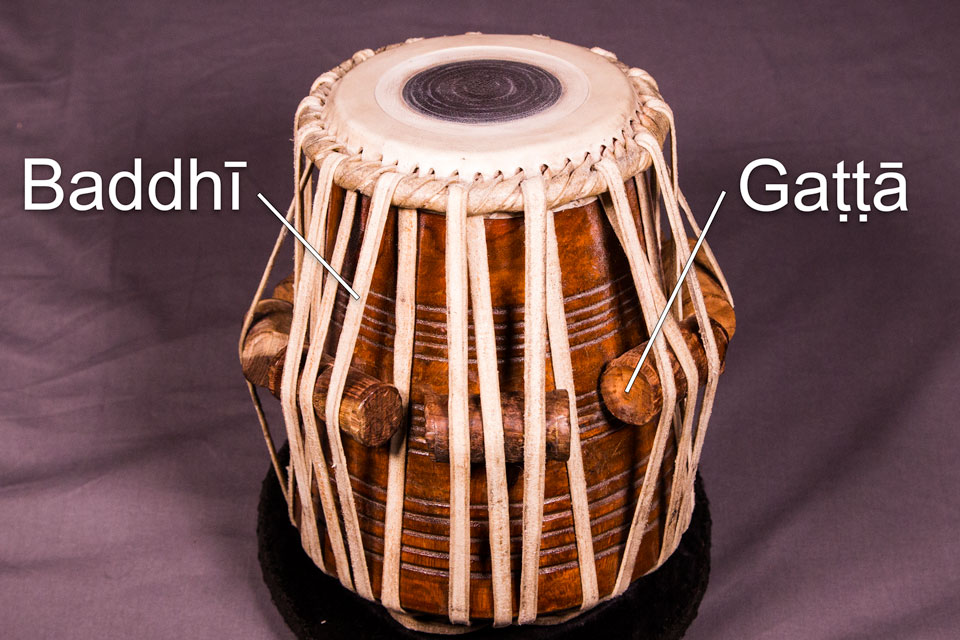
Fasteners
Baddhī – बद्धी
Also called tasmā (तसमा).
Both baddhī and tasmā mean "cord" or "strap". This is one long piece of rawhide used to bind the puri to the drum shell.
The baya’s baddhi may also use rawhide, or a variety of rope materials. Synthetic baddhis are now sometimes used for both drums.
Gaṭṭā – गट्टा
Gaṭṭā ("stopper" or "plug") refers to the wooden dowels used to adjust the tension of the baddhi. To increase the tension, you knock them down; to increase the tension, knock them up.
Kunḍal – कुंडल
The kunḍal ("ring" or "hoop") is a sturdy ring of rawhide which fastens the baddhi to the bottom side of the drum.
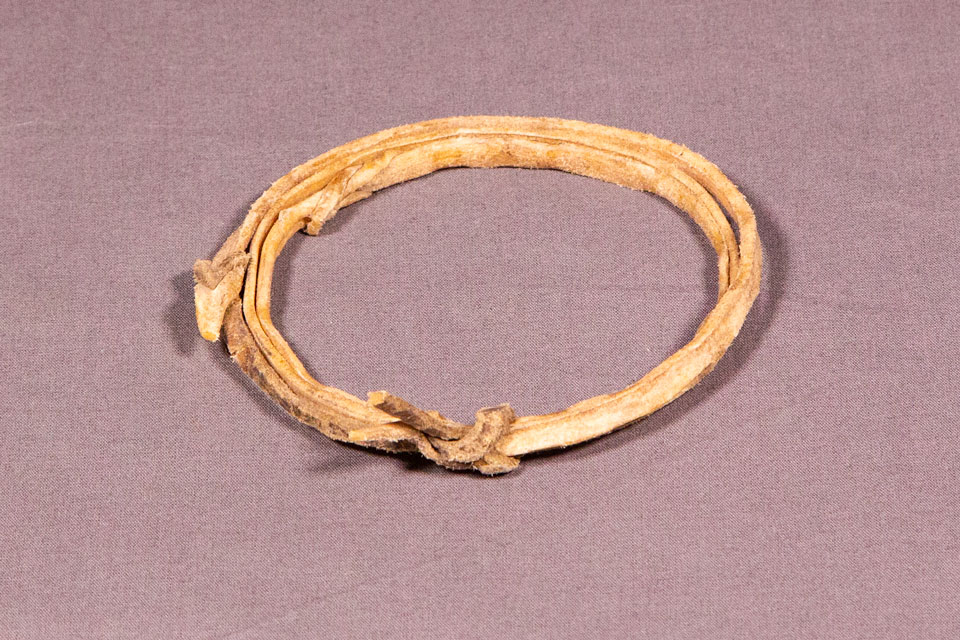
Kundal
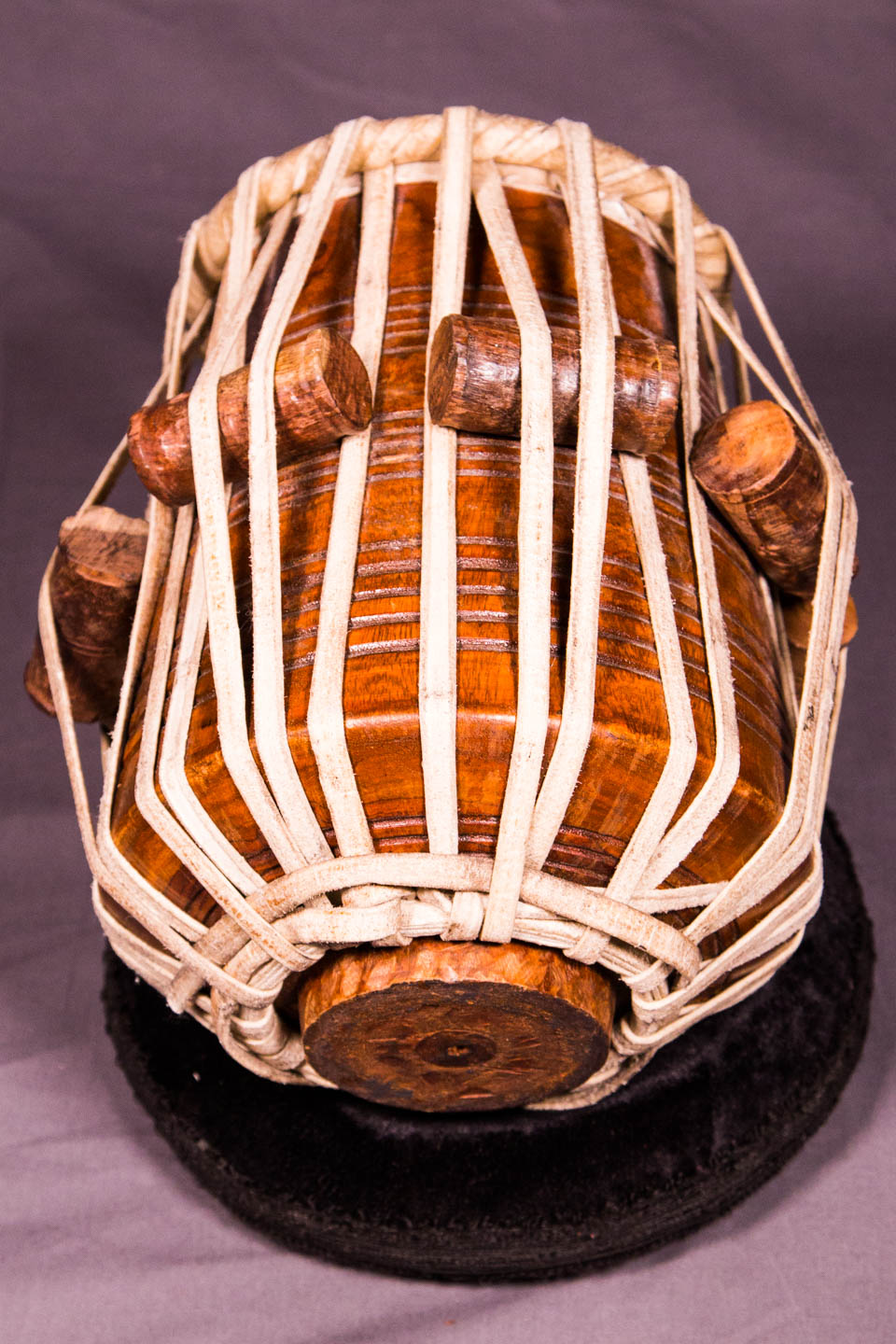
Kundal on Bottom of Daya
Hammer and Rings
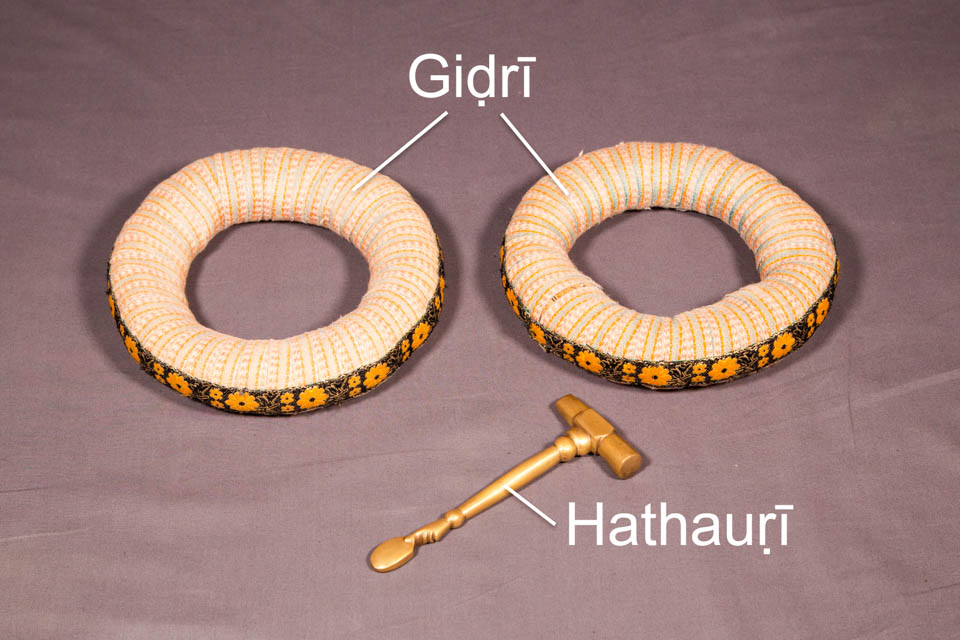
Support Rings and Tuning Hammer
Hathauṛī – हथौड़ी
Hathauṛī (“hammer”) is a special hammer used for tuning the drums.
Giḍrī – गिडरी
Giḍrī is one of various names used for the rings that support the drums when played.